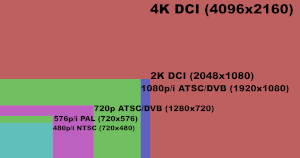Video scaler

A video scaler is a system which converts
Video scalers are typically found inside
Video scalers are primarily a
Process
This section needs additional citations for verification. (July 2022) |

The
While scaling a video signal does allow it to match the size of a particular display, the process can result in an increased number of
Scaling by television channels
Television channels which air a mixture of
When the U.S. cable network
In 2014, FXX faced similar criticism for its use of cropping and scaling on reruns of The Simpsons (which only started producing episodes in HD beginning in its 20th season), as its cropping method caused various visual gags to be lost. In February 2015, FXX announced that in response to these complaints, it would present these episodes in their original 4:3 aspect ratio on its video-on-demand service.[3][8]
Since about 2008, some networks and cable companies have run high-definition versions of old programing that was originally shot on film shown in the 4:3 format. This format always cropped the sides of the image. For example, syndicated broadcast stations and the cable network
AI upscaling
In 2023, video upscaling products using generative artificial intelligence were previewed or released, such as NVIDIA's Video Super Resolution and Adobe's Project Res-Up. Unlike previous upscaling systems, these technologies generated new data based on provided video frames.[10][11][12]
See also
References
- ^ "Video Upscaling for better viewing experience". hometoys.com. 2011-05-25. Retrieved 2013-03-07.
- ^ a b c "TNT Stretches for HD". TV Week. Retrieved 2008-08-10.
- ^ a b "FXX will finally stream The Simpsons in original 4:3 format". The Verge. 13 February 2015. Retrieved 13 February 2015.
- ^ Bob Wolfley (September 2, 2010). "Fox Sports taking a wider view of football". Milwaukee Journal Sentinel. Journal Communications. Archived from the original on September 5, 2010.
- ^ "Beyond HD". BBC Academy. Retrieved 3 June 2015.
- ^ "Managing AFD: Keep image format under your control". TV Technology. January 2009. Retrieved 5 June 2016.
- ^ "Just say no to stretch-o-vision". EngadgetHD. Retrieved 2008-08-10.
- ^ "FXX ruins the punchline by inexplicably cropping old standard definition 'Simpsons' episodes". The Verge. 24 August 2014. Retrieved 13 February 2015.
- ^ "Seinfeld goes HD on TBS HD". AOL. September 3, 2008. Archived from the original on January 16, 2013. Retrieved July 24, 2019.
- ^ Anderson, Ross (9 December 2023). "The Best AI Tool You're Not Using is Video Upscaling". The New York Sun.
- ^ Weatherbed, Jess (11 October 2023). "Adobe previews AI upscaling to make old, fuzzy videos and GIFs look fresh". The Verge.
- ^ Chacos, Brad (28 February 2023). "Tested: Nvidia's RTX Video Super Resolution is like going from VHS to Blu-ray". PC World.
